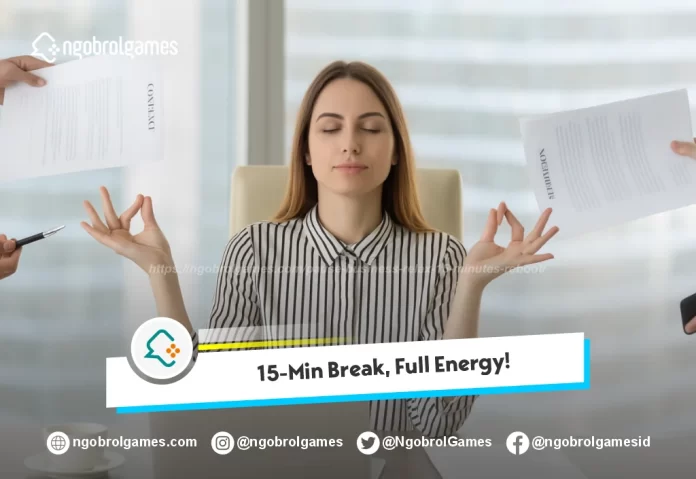You are not too lazy; you are exhausted. Consecutive calls, 87 browser open tabs, zero concentration. Your brain is not a machine, but it is overloaded. And no, 10 minutes of doomscrolling Twitter is not a break. You require a real break, one that is effective. It is 15 minutes. To clear your head and decongest the mind, wash and get back with a keen eye and a cooler heartbeat. The majority of individuals are burnt out due to a lack of breathing. You do not require a vacation. It takes you 15 brainy minutes. This is the way to make them count. Begin to do this now: your concentration, productivity, and sanity require it.
Understand the Importance of Short Breaks
Here’s the truth: breaks aren’t a waste of time—they’re a reset button your brain needs. They help you stay sharp, not lazy. Even taking a few minutes to scroll through the ꓟеꓲꓐеt арр can give your mind a quick breather. Your brain isn’t a machine that runs nonstop. Without proper pauses, you lose focus fast, make worse decisions, and hit mental fatigue. That’s how errors creep in. A 15-minute break isn’t a treat—it’s maintenance for staying sharp.
Mini breaks cause a change in your nervous system. They reduce stress hormones, reset your working memory, and restore your attention. It is supported by research that cognitive activity is enhanced when you take a break. It is all about intent. It is not enough to look at your mobile phone and consider it a rest. Put that window to good use, and your yield skyrockets. It is not fluff; that is neuroscience.
Choose the Right Time to Pause
There is no randomness in timing. An interruption at an inappropriate time kills flow. However, when it is done well, it will open up to sharper focus and greater energy. Use the following triggers:
- Right after a mentally intense task: Give your brain space to recover.
- Mid-morning or mid-afternoon: Natural dips in alertness happen here.
- Before starting a new type of task: Switch gears with a mental reset.
These are not mere speculations but are supported by circadian rhythms and work productivity statistics. Be familiar with your rhythm. So, if you continue to overreach your dip zone, you are not working hard; you are working poorly. Take breaks as you schedule meetings. The reward is authentic.
Quick Reboot Techniques
A good 15-minute break is not a guess. It’s a strategy. What you desire are behaviours that can physically or psychologically alter your condition. That is, taking yourself out of autopilot and doing something that resets either your body or your brain-fast. It is not the point of not working. It is to do something to have your system a legitimate recharge. It is encompassed in two solid categories, namely physical movement and mental reset. Choose according to what you feel: wired, sluggish, foggy, anxious. The correct decision not only distracts you, but it also makes you sharper and calmer.
Move Your Body
When your energy drops or you’re slipping into a slump, get up. A bit of movement wakes your system fast. You don’t need to do much—even checking scores or odds on the ꓟеꓲꓐеt bеttіոց соmраոу app while stretching can help you switch gears. This isn’t about fitness; it’s about getting your brain out of idle mode. Hamstring stretch. Quick stairs. Walk around the block. Just get the blood moving.
Your body influences your brain. Exercise increases oxygen, ignites concentration, and kicks slackness in the butt. You can spend six hours straight sitting, but you will not be productive; you will be stiff and slower. The brief action tells your brain, “Hey, we are not dead.” You will be back loser, more in focus, and be able to think straight.

Calm Your Mind
Mental clang is as fierce as physical exhaustion. Stillness beats a spinning head. No Slack, no screens, no scrolling. Just quiet. Box breathe, four seconds in, four out, repeat. Or put your headphones on with noise-cancelling on and close your eyes.
Do not think too much. Meditation does not require incense and a cushion on the floor. It only requires you to disconnect as input. When the body is awakened by movement, calm drills reset the brain. You are not checking out, you are clearing the ache. When it is quiet after 10 minutes, everything seems cleaner. Less fog. More control. Pause and real results.
Avoid Common Break Mistakes
The majority of individuals do not take real breaks; they only switch screens. Exchanging email with Instagram does not reboot your brain. It puts you in a reactive state. You are still reacting, still scrolling, still thinking. It is not a break. That is simply exchanging stress factors.
The other typical slip-up: trying to multitask your sleep. Munching at lunchtime without concentrating on a video in fast-forward mode is not a rest. Nor is walking with responding to messages. Breaks are only effective when they separate you from output. When you have productivity in your pause, your brain does not go out of gear. Take a complete step back, or you will return as depleted as you were.
Make It a Habit
Infrequent rest does not solve chronic overload. The restart is effective only when you program it in. Schedule it into your calendar. Take it as a meeting that you cannot miss. No one is too busy to spend 15 minutes. Practice it every day, and your mental endurance increases. You will work more, not harder, but smarter by recovering.

